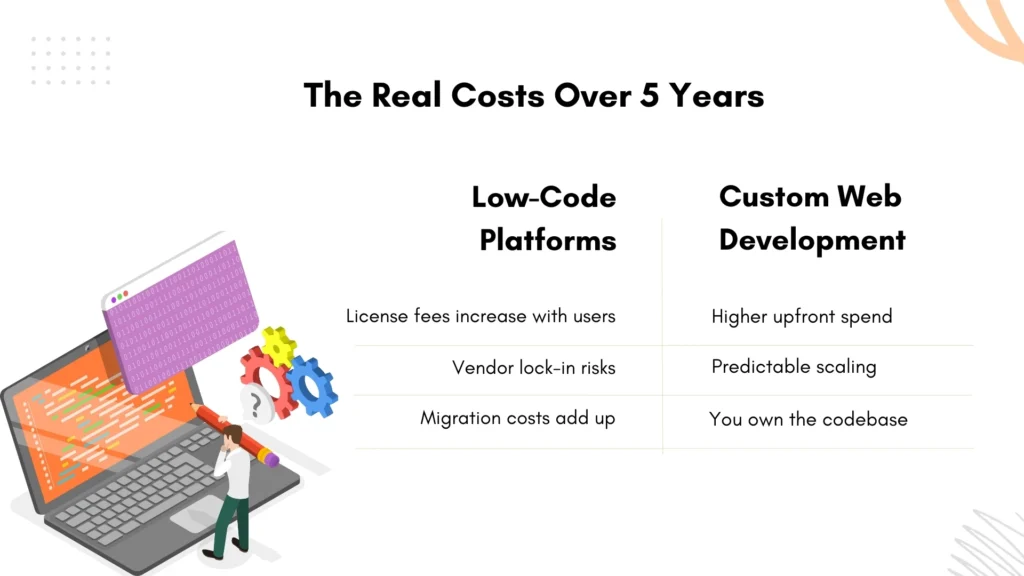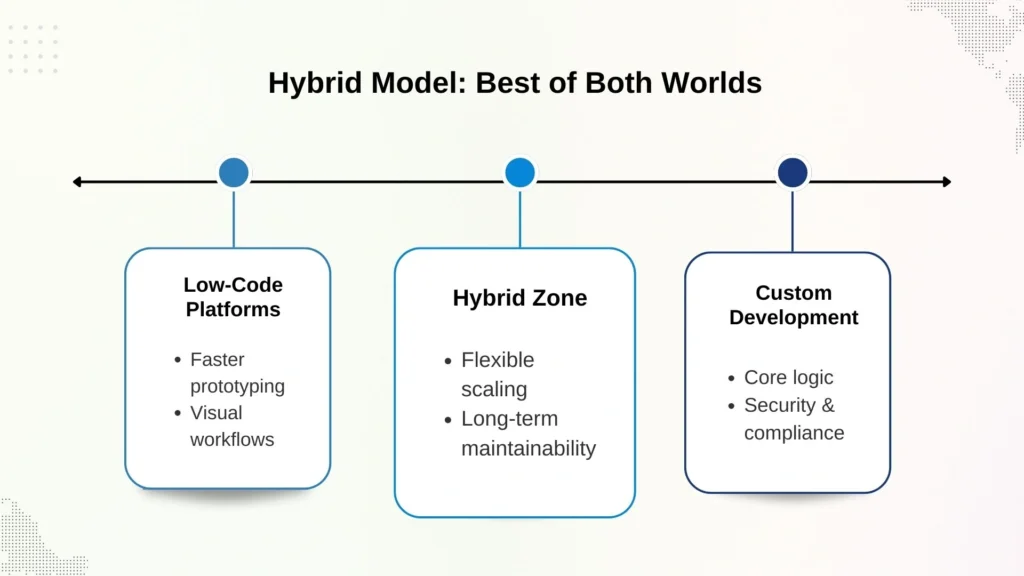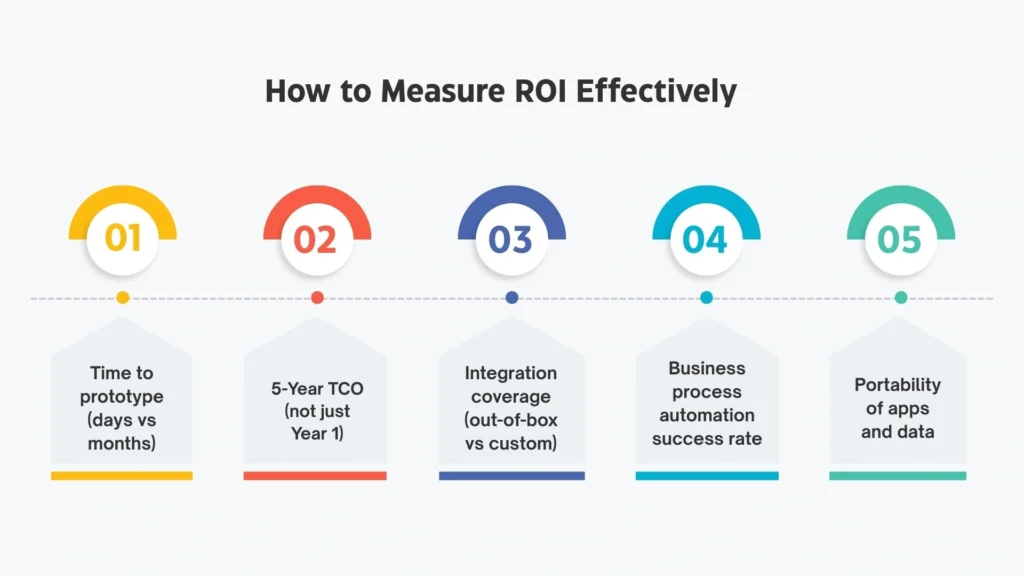The debate around low-code platforms and custom web development is no longer just academic. Businesses are being pressured to create software more quickly, at less cost, and with the flexibility required to be long-term. The question business owners, CTOs, and product managers continue to pose is easy: which approach actually saves time and money in the full lifecycle?
We can examine it by breaking it down and looking at where speed is a real consideration, how costs add up over time, and what factors can too often be ignored when deciding between Low-code development and traditional coding.
The Speed Factor: Where Low-Code Excels
The most apparent advantage of low-code platforms is speed. Templates and simple customer-facing apps can be constructed within weeks, rather than months, by teams using drag-and-drop interfaces, templates, and Visual development tools. To most organizations, this is a revolution.
A workflow can be designed by a finance manager, but he/she needs good knowledge of programming. Reporting can be automated by a business analyst. This is rapid application development in practice: short cycles, frequent iterations, and fast time-to-market.
Low-code is a true time-saving solution when the objective is to rapidly validate an idea, or to automate routine processes with Business process automation. It is popular in hackathons, proof-of-concepts, or small apps, where scale and integration with other systems is not the defining issue.
The Real Costs Behind the Sticker Price
Speed is appealing, but actual saving is based on Total cost of ownership. The problem with many decision makers is that they only look at the costs in the first year; licenses, initial set-up and training. The bigger picture includes:
- Licensing models: Most enterprise low-code development suites charge per user or per app. As usage grows, fees escalate quickly.
- Vendor lock-in: Exporting apps and data can be costly or technically restrictive. If you outgrow the platform, migration expenses spike.
- Maintenance fees: You’re dependent on the vendor’s release schedule. If an update breaks a feature, you wait for them to fix it.
- Hidden consulting costs: Many organizations end up hiring platform specialists for integration and scaling costs that rival traditional coding over time.

By contrast, custom web development often looks expensive upfront but becomes more predictable in the long run. You own the codebase, control deployment, and scale based on your own infrastructure. The upfront investment buys you future flexibility.
The Case for Custom Development
Custom web development is the choice when performance, scalability, and differentiation matter. A customer-facing platform that needs unique workflows, specialized algorithms, or high concurrency benefits from custom code.
A web development firm specialising in web development services can create custom systems that will fit in with the current infrastructure. In comparison to low-code solutions, custom applications can be optimized to be fast, resource-efficient, and easy to use.
Custom is also appropriate where ownership over the long run is crucial. A shopping platform, a medical application that needs regulatory standards, or an app in the fintech sector that demands high standards of compliance is safer in a codebase that you have complete control over.
The Hybrid Approach: Best of Both Worlds
Conversation is not necessarily dualistic. It is common practice to use both low-code and custom approaches within a single organization: low-code as the speedy approach, and core systems as the custom approach.

Here’s a common pattern:
- Use low-code platforms for the front-end or workflow automation.
- Build custom services with a Microservices architecture for critical business logic.
- Connect both using APIs, ensuring the platform is just a delivery layer while business rules live in code you own.
This trades off time-to-market with long-term resiliency. Should the low-code tool be retired or replaced, the microservices are not lost and your core investment is not lost.
DevOps and Testing: The Silent Time Sink
The operational reality is ignored by most people. The first is to create an app; the second is to support it, the marathon.
Low-code tools promise instant deployments, but real-world production needs:
- Continuous Integration/Continuous Deployment (CI/CD)
- Automated testing
- Monitoring and observability
- Rollback and recovery strategies
Without these, every “quick release” increases the risk of downtime. Custom code often has these pipelines baked in by experienced developers. . A web development agency that delivers website development services should include automated tests and deployment pipelines in its offer. Skipping this step is where projects bleed both time and money later.
Integration and Extensibility
Businesses do not work in silos too often. Applications must have access to CRMs, ERPs, payment gateways and third-party APIs.
Low-code vendors also market pre-built connectors, but they are only so useful. When you require a specific-purpose integration or a specific authentication flow, you run out of platform capabilities. There are code extensions in some tools, but not all.
Naturally, custom solutions are scalable, particularly when it is designed using a Microservices architecture. A service will be able to scale up and down on its own, without influencing the entire system. This scalability is interpreted into cost savings since you only scale what is required.
Compliance and Security: Cost of Getting It Wrong
Most decision makers do not take into account compliance costs. Most financial services, healthcare, and government apps are subject to regulations such as HIPAA, PCI DSS, or GDPR. Fines act as deterrents to compliance.
Low-code vendors often provide security certifications, but you still share responsibility. Data residency, audit trails, and fine-grained access controls may require additional investment.
Custom development places the burden squarely on your shoulders but allows you to exert control over the achievement without compromising with industry-specific compliance.
Migration and Exit Planning
Another form of cost driver that is not much spoken about is exit strategy. What would happen should you have to leave your platform of choice?
Low-code exporters may restrict themselves to proprietary formats, which is labor-intensive to migrate. This upfront planning allows you to avoid vendor lock-in becoming a crisis in the budget.
Migration planning should be part of the scope of a web development company that provides web development services. Where low-code are used by teams, make sure that contracts state that data can be ported and exported.
Who Builds the App?
The promise of low-code is that business users can create apps. Reality is more complex. With Visual development, you still require architects/developers to maintain, provide security and integrate.
The sweet spot is to match business users who are familiar with the workflow to technical personnel who handle architecture and compliance. This combination has the benefit of speeding up delivery and avoiding expensive rework.
Custom projects, meanwhile, demand professional teams from the start. A skilled web development agency ensures designs are future-proof and scalable, reducing technical debt that balloons over time.
Metrics That Reveal Real Savings
If you want to know what actually saves time and money, measure these:

- Time to prototype: days vs. months.
- Year 1 vs. Year 5 TCO: license, hosting, migration, and staffing included.
- Integration coverage: percentage of systems connected without custom workarounds.
- Automation success: how much Business process automation was achieved.
- Portability: ease of exporting code and data without disruption
Monitoring of such figures will ensure that decisions are made based on evidence and not marketing aspirations.
Low-Code as a Tool for Digital Transformation
The debate should be put in a larger context. Digital transformation is viewed by many organizations as a sequence of small wins: automate a manual process, modernise an old system or provide non-technical employees with the tools to create solutions.
That is where Low-code development is a massive boost. It reduces the entry barrier, enables experimentation and provides fast business value. However, larger scales, including platforms with thousands or millions of users, applications with mission critical workloads, etc. are often in need of bespoke code.
FAQ’s
Custom web development builds software from scratch for full control and scalability, while low-code platforms focus on speed and Rapid application development.
Low-code reduces upfront costs but long-term Total cost of ownership can rise due to license fees, scaling costs, and vendor lock-in.
Choose custom when you need advanced integrations, strict compliance, or performance at scale.
Hidden costs include rising license fees, vendor lock-in, specialist hiring for integrations, and migration challenges.
Business users can design workflows, but technical staff are essential for architecture, testing, and long-term maintainability.
Yes, but it can be complex. Planning an exit strategy early with a web development services partner saves both time and money.




























